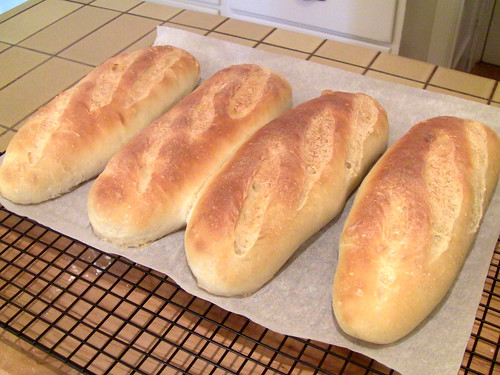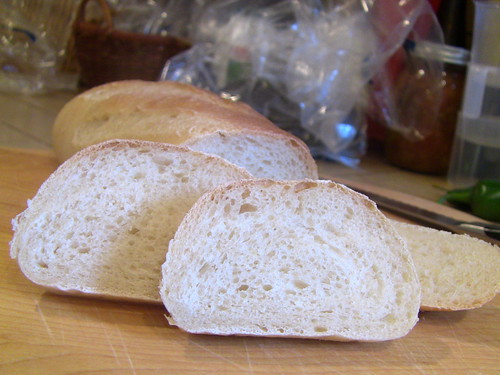
Recipe ideas come from a variety of inspirations. I love Carnitas. I love Duck Confit. I love Cubano sandwiches. I recently had an excellent—if non-traditional—Cubano sandwich that had spicy pulled pork (with Chiles and Coriander) in place of the traditional sliced roast pork. I happened to have some crushed Coriander seed left over from Pastrami rub. I looked at a bunch of recipes for Carnitas and Cuban-style pork, and went from there.
The result is a semi-hot, complexly spicy and delicious, moist but crispy, pulled duck (yes, David, I know…they quack loudly if you pull too hard). The balance of spices is inspired (modesty aside)—you can taste each spice but they meld nicely. It made a wondrous Cubano Sandwich, with Gruyere, sliced Kosher dills and homemade Chipotle–Lime Sauce, all on a home-made Po-Boy Roll (recipe below).

Ingredients:
6 Duck Legs
Kosher Salt
Fresh ground Black Pepper
½ tsp Chile Powder
1 dried Ancho Chile, seeded and minced
2 dried Chipotle Chiles, seeded and minced (or 1 or 3, for less or more heat)
¼ tsp ground Cumin
1 tsp dried Oregano
2 Bay Leaves, broken in half
2 tsp crushed Coriander Seeds
½ tsp crushed Anise Seeds
4 Cloves Garlic, sliced
4-6 oz. Chicken Stock, hot
Juice of 2 Mexican Limes
Procedure:
Three to twelve hours before cooking, wash and dry the duck legs and sprinkle them well with salt and pepper. Cover and refrigerate.
Pre-heat oven to 450 F.
Mix up the spices listed above from Chile Powder to Anise seeds. Lightly oil a heavy pot or Dutch Oven that will fit the duck legs in a single layer fairly tightly. Add the duck legs and roast for 1 ¼ hours, turning them mid-way.
Remove the legs to a plate and spoon out all but a thin layer of the rendered fat. Pour an ounce or so of the hot stock into the pot and scrape loose the stuff at the bottom of the pot. Return the legs to the pot and sprinkle with the spice mix, lime juice and garlic slices. Pour the stock into the pot until the legs are about 2/3 covered.
Return the pot to the oven, uncovered. Lower temperature to 400 F. Braise for two hours or until most, but not all, of the liquid is gone, turning the legs once or twice and basting every 20-30 minutes. The legs should be nicely browned and very tender. [Note: during this stage, if you need the oven—say, to bake some bread—the pot can be moved to the stove on simmer and covered].
Remove the pot from the oven and remove the legs to a plate. With a slotted spoon, remove most of the solids (garlic, bay, chile and seeds). When the legs have cooled, remove the bones (and skin and fat if you like) and shred the meat into rough shreds.
Return the shredded meat to the pot, stir to moisten, and return to the oven. Reduce heat to 350 F. Roast for 45-60 minutes uncovered, stirring occasionally, until there is no liquid remaining but the meat is still moist.
The Rolls
And here’s the recipe for the Two-Starter Po-boy Rolls, adapted from a recipe by Bernard Clayton, brought to my attention by ehanner (http://www.thefreshloaf.com/node/4329/po-boy-victory). I thought adding two pre-ferments (a poolish and a levain, as in proth5’s Bear-guettes) might enhance the flavor. I honestly can’t say it made a big difference, but the rolls were excellent—crispy crust and soft innards.


Mixed Starter Po-Boy Rolls
Poolish:
¼ tsp Instant Yeast
2 oz. Water room temp
2 oz. AP Flour
Levain:
½ oz. Active Starter
2 oz. Water
2 oz. AP Flour
Main Dough:
1 ½ tsp Instant Yeast
2 Tbsp Nonfat Dry Milk
1 Tbsp Sugar
1 Tbsp Salt
20 ½ oz. AP Flour (divided)
12 oz. Warm Water (100 F)
Poolish
Levain
1 Tbsp Butter (room temp)
1 Tbsp. Cold Water
Method:
Mix the levain and the poolish 12 hours ahead.
Mix together 10 oz. with the flour, and the yeast, dry milk, sugar and salt.
Mix the levain, polish, and butter into the warm water and add to dry ingredients. Mix well (2 min with beater blade). Switch to dough hook and add remaining flour 1/2 cup at a time. Add additional flour if needed to get to a shaggy elastic but not sticky mass. Cover and rest for 10 minutes.
Knead on speed 2 for 10 minutes. Dough should clean sides of the bowl, adjust flour accordingly.
Turn out into a lightly oiled bowl with at least 2-1/2 times the capacity and cover. Let rise until doubled (1-1-1/4 hrs).
Punch down and turn out onto a lightly floured surface. Knead briefly to degas. Divide into 4 pieces. Pre-shape into a loose rectangle and cover loosely, rest 10 minutes.
Shape using baguette technique. Seal the seam and ends. Roll and stretch to desired length and place on parchment lined sheet. Cover loosely with saran and proof for 45-60 minutes. The dough should double easily in 45 min.
Pre-heat oven to 400F.
When proofed, brush dough with cold water, slash, steam oven and bake for 35 Minutes. Rotate half way through for even color. Bake to a golden brown (25-30 Minutes). Cool on a rack.
Glenn